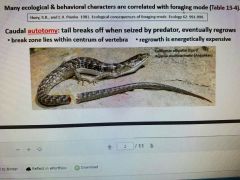![]()
![]()
![]()
Use LEFT and RIGHT arrow keys to navigate between flashcards;
Use UP and DOWN arrow keys to flip the card;
H to show hint;
A reads text to speech;
47 Cards in this Set
- Front
- Back
- 3rd side (hint)
|
Opisthoglyphus |
Venomous snakes with enlarged teeth in rear of jaw. Rear fanged snakes |
|
|
|
Annuli |
Rings extending around a structure. |
|
|
|
Proteroglyphous |
Venomous snakes with permanently erect fangs at front of mouth. (Cobras and mambas and relatives) |
|
|
|
Fossorial |
Specialized for burrowing. (Amphisbaenians) |
|
|
|
Zygodactyl |
Type of foot which the toes are arranged in two opposable groups. (Chameleon) |
|
|
|
Solenoglyphous |
Venomous snakes with long fangs in front of jaw that rotate when mouth opens. (Vipers) |
|
|
|
Autotomy |

Voluntary release of a portion of the body to escape a predator, as when a lizard loses its tail. Autotomized structures are regrown |
|
|
|
Oviparity |
Form of reproduction in which a mother deposits eggs that developed outside her body. |
|
|
|
Precocial
|
Well developed and capable of locomotion soon after birth or hatching - like chickens and cows. |
|
|
|
Viviparity
|
Form of reproduction in which the mother gives birth to a fully developed baby, as opposed to laying eggs. |
|
|
|
Parthenogenesis
|
|
|
|
|
Chorioallantoic placenta
|
A placenta developed from the chorionic and allantoic extraembryonic membranes that replaces the choriovitelline placenta during the embryonic development of all eutherian mammals and some marsupials |
|
|
|
activity temperature range
|
range of body temperatures that an ectothermal animal maintains when it is thermoregulating. |
|
|
|
Angiosperms |
Most recently evolved of vascular land plants characterized by seed enclosed in tissue derived from ovary |
Important to success of Vertebrate evolution. |
|
|
Gigantothermy |

ability of an extremely large animal to maintain a constant and relatively high body temperature due to its low surface:volume ratio. |
|
|
|
Pterylae
|
Tracts of follicles from which feathers grow. |
|
|
|
Apteria
|
Regions of skin without feathers |
|
|
|
Down Feather
|
entirely plumulaceous feathers in which the rachis is either shorter than the longest barb or entirely absent. |
|
|
|
Semiplume
|
feathers intermediate in structure between contour feathers and down feathers |
|
|
|
rectrices
|
tail feathers
|
|
|
|
Remiges
|
Wing feathers |
|
|
|
Furcula
|
Avian wishbone formed by the fusion of the two clalvicles at their central ends |
|
|
|
Synsacrum
|
fused vertebrae and ribs of birds that are fused with the pelvis |
|
|
|
pygostyle
|
Fused caudal vertebrae of a bird that supports the tail feathers. |
|
|
|
tibiotarsus
|
A bone formed by the fusion of the tibia and proximal tarsal elements in birds and some dinosaurs. |
|
|
|
Tarsometatarsus |
A bone formed by the distal tarsal elements with the metatarsals in birds and some dinosaurs. |
|
|
|
Cambered Airfoil |
an airfoil that has a curved upper surface and a flat lower surface.
|
|
|
|
lift
|
vertical force opposed to gravity |
|
|
|
Alula |
tuft of feathers on the first digit of a birds wing that reduces turbulence in airflow over wing. |
|
|
|
Angle of Attack |
verticle angle between a chord line of an airfoil and the direction of motion of the fluid through which the air foil is moving. |
|
|
|
Drag |
backward force opposed to forward motion |
|
|
|
Aspect ratio |
ratio of length of a wing to its width. |
|
|
|
Anisodactyl |
Arrangement of toes seen in perching birds, with three in front opposed to one behind. |
|
|
|
Zygodactyl |
Type of foot in which toes are arranged in two opposable groups |
|
|
|
Monogamy
|
Mating system based on a pair bond between a single male and female. |
|
|
|
Social monogamy |
mating system in which male and female share parenting responsibilities, but mate with individuals outside the pair. |
|
|
|
Genetic monogamy |
social system in which a male and female share parental responsibilities and do not mate with individuals outside the pair. |
|
|
|
Polygamy
|
mating system in which an individual has more than one mate in a breeding season.
|
|
|
|
Polygyny
|
mating system in which a male mates with more than one female
|
|
|
|
Polyandry |
mating system in which a female mates with more than one male |
|
|
|
Promiscuity
|
breeding system in which both males and females have more than one mate in a breeding season. |
|
|
|
Extra-pair Copulation |
mating with an individual other than the partner in a monogamous breeding system. |
|
|
|
Precocial |
Well developed and capable of locomotion soon after birth or hatching (like chickens and cows) |
|
|
|
Altricial |
Helpless at birth or hatching (like pigeons and cats) |
|
|
|
Zugdisposition |
preparation for migration by accumulating fat
|
|
|
|
Zugstimmung |
condition in which a bird makes migratory flights |
|
|
|
Zugunruhe |
restlessness of caged birds that are prevented from migrating. |
|

